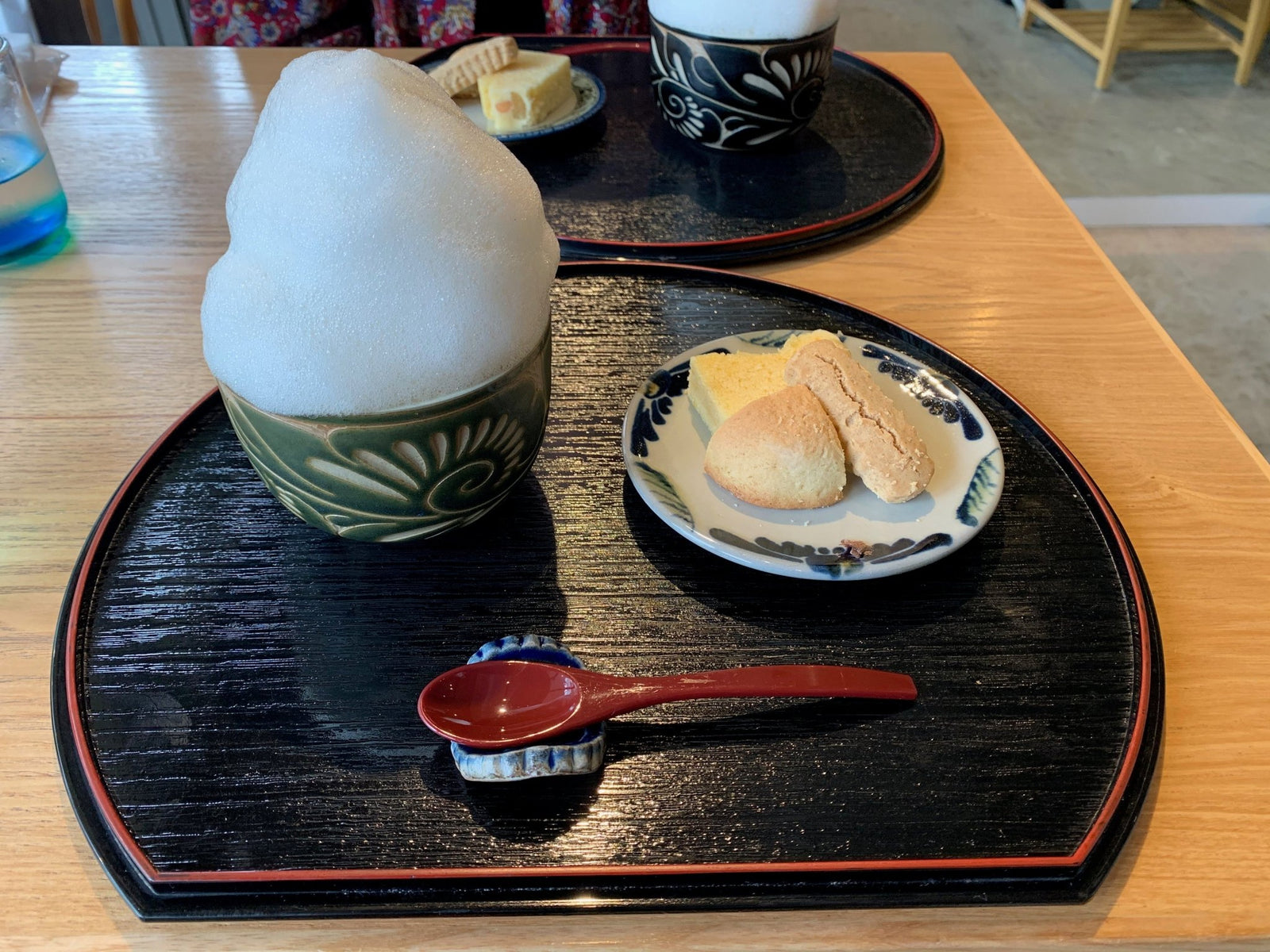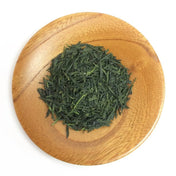The clouds are white and fluffy (Japanese: fuwafuwa) today.

The sand at the beach was so smooth (Japanese: sarasara) that the wind and our footprints made beautiful imprints.

The Japanese fermented soybeans natto, has a slimy (Japanese: nurunuru) texture which some people find to be discomforting.
 Photo by 自然さん (photo-AC).
Photo by 自然さん (photo-AC).
If you know a bit about the Japanese language or have been to Japan, you may have encountered some of our fun onomatopoeias, which non-native Japanese often find intriguing. For the purposes of this post, I will of course not go into an extensive list of the onomatopoeias in our language. However, did you know there are some Japanese teas that are named with onomatopoeias? Here is an introduction to these unique teas!
Batabatacha
Perhaps the most well-known out of the three teas I will be touching on today, batabatacha is a regional, traditional bancha originating from the 15th century town of Asahimachi Birudan in Toyama prefecture. It is a post-fermented tea which is prepared boiled, which may remind you a bit of the Chinese pu-erh tea. However, it is unique in that it was traditionally drunk whisked and foamed with a pinch of salt. While its roots are in Asahimachi Birudan, it has also been historically enjoyed in the neighboring prefecture of Niigtaa Prefecture in the Itoigawa region. Why “batabata”? In Japanese, “batabata” is an onomatopoeia which captures commotion and rushing. When used as an adverb, it signifies flapping (e.g., birds wings), rattling or cluttering noise. Particular to the tea, it captures the sound of whisking this unique regional tea to a froth.
 Batabatacha leaves; Furyu Bancha Shop's Batabatacha from Asahimachi, Toyama Prefecture. Photo by Furyu.
Batabatacha leaves; Furyu Bancha Shop's Batabatacha from Asahimachi, Toyama Prefecture. Photo by Furyu.
Historical Roots
The earliest known historical record of this tea comes from a 1472 visit of Rennyo, the 8th head priest of the Jodo Shinshu sect of Buddhism. Rennyo noted that the locals were combining this tea with rice and alcohol into a single dish that was eaten/drunk. Some say that the tea was consumed earlier than this date and while its exact roots are unknown, the process is said to have come from China.
Unfortunately, tea production Asahimachi Birudan died out by the 1970s, and the people purchased their batabatacha from tea farmer Hideo Shimizu in Mihama Village, Fukui Prefecture. In 1975, the aging Shimizu-san had decided to stop production, and Akinobu Hagiwara of Kosugi Village, Toyama Prefecture learned the process, taking over tea production. Subsequently, in the 1980’s, the people of Asahimachi Birudan decided to learn how to make batabatacha from Hagiwara-san in order to preserve this precious tradition. Through these efforts, tea fields were established in the village in the 1990s. With the help of Kagawa University Professor Kinjiro Miyagawa, the village improved the quality of their tea bushes and leaf processing, and now production has become a community project led by the local chamber of commerce. Pretty neat story!
Process of Making Batabatacha in Asahimachi Birudan Today
- The batabatacha harvest generally occurs in late July from the Yabukita cultivar. Tea leaves are harvested along with the upper part of the branch.
- The leaves and young branches are then taken to the batabatacha factory in the village and roughly chopped up.
- The steaming process stops the oxidative function of enzymes (*Note that this step allows the tea to be classified as a green tea, and not into an oolong or black tea).
- The heat is dissipated and thicker branches are removed.
- The tea leaves are roughly rubbed, and piled over a cloth inside a large storage box called a “muro”.
- Tea leaves are maintained at 60 degrees Celsius (140 °F; *this is very important!), over a period of 2-3 days to allow for an even fermentation and to avoid damaging the leaves. This process of keeping the temperature at 60 degrees is maintained over a total period of approximately 40 days and requires skill and hard work. The temperature is maintained by heat from the fermentation process itself and the central parts will rise higher in temperature. To avoid higher temperatures, leaves are moved around to different “muros” or through reorganizing the pile. This step is complete when the tea leaves become sufficiently soft and when the temperature stops rising.
- At the beginning of September, the tea leaves are finally ready to be dried indoors/in the shade first, and then sun-dried (across a period of 2-3 days) to completely stop the oxidation process.
Considering this hard work and the fact that batabatacha is fermented during the hottest period in the summertime, it is hoped that one may appreciate this regional folk tea even more! While the website is in Japanese, Asahimachi has a very nice webpage that captures snapshots of the village people making Batabatacha.
Tea Culture of Batabatacha in Birudan
According to historical records of Asahimachi Birudan, tea was a drink which strengthened “kizuna” (Japanese character: 絆;definition: bonds/connections) between people. Perhaps, this aspect was especially strong in the people of this village. This was a natural tendency, as tea was consumed in social gatherings and contexts. For instance, after the majority of the family had left for work or school, the grandmas of the village would gather together to enjoy their cup of batabatacha. The batabatacha was also served and enjoyed in various buddhist affairs and ceremonies. For marriage, birth, funerals, graduation, employment, coming of age day, the list goes on… Yes, the cha-no-ma culture was very prominent amongst the people of Birudan. In this sense, tea was both ceremonial and casual in that it intentionally marked a specific occasion but it was also shared amongst close relatives and family in a convivial and friendly atmosphere.
Unique Aspects of Batabatacha
Traditionally, batabatacha requires a special bowl and whisk. The pottery that was born in Asahimachi Birudan is called Gorohachi chawan (Japanese: 五郎八茶碗) and this bowl has a slightly narrow mouth. For the whisk, there is a traditional coupled bamboo whisk made specifically for whisking the local batabatacha (from Toyama and Niigata Prefectures). In Japanese it is called a "meoto chasen", literally "husband and wife tea whisk". Of course, one can improvise without this particular whisk and bowl and still enjoy the taste of batabatacha! In fact, the local people also drank unwhisked batabatacha with their everyday meal. Personally, I find it can be quite nice as an afternoon tea and we’ve brought it a few times on our hiking trips where its rustic vibe complements the outdoors.

The Meoto chasen (husband and wife whisk) available on Yunomi for the batabatacha fans out there who want to utilise this unique whisk. This whisk could also serve as a wonderful gift along with batabatacha to a newly wed. Photo by Seikoen.
Botebotecha
Less known in comparison to batabatacha, botebotecha originated in Izumo, which is the current Matsue City, the capital of Shimane Prefecture. Botebotecha is made from tea leaves and branches that are harvested around October, then dried in the shade for approximately a month (this type of bancha is called: Hikage-bancha) and mixed with dried tea flowers. Like the batabatacha, the traditional way of making this tea involves whisking. To prepare the tea, the bancha tea leaves and the dried tea flowers are boiled together. The tea is then cooled off a bit and poured into a bowl. Then, the bowl is shaken from left to right and whisked with a long bamboo whisk that is dipped with salt. It is said that the tea flowers contain saponin, which helps to create a large amount of foam. Indeed, botebotecha looks like a white foamy drink!
 Even though it may be difficult to gather all of the traditional ingredients, you can always improvise with the ingredients and enjoy botebotecha at home. At Yunomi, we have Botebotecha from Ocha no Sankoen, Shimane Prefecture, Japan available for purchase. Photo by Teamona.
Even though it may be difficult to gather all of the traditional ingredients, you can always improvise with the ingredients and enjoy botebotecha at home. At Yunomi, we have Botebotecha from Ocha no Sankoen, Shimane Prefecture, Japan available for purchase. Photo by Teamona.
What is perhaps interesting about the botebotecha is that it can act as a comfort food, like ochazuke, and is traditionally consumed with local and seasonal ingredients. While it varies across households, common ingredients include a small portion of rice, black beans (or rice with red beans, called sekihan), seasonal pickles (tsukemono), shitake and tofu skin. Once the tea is whisked, these ingredients are added and that is how it is enjoyed. It appears that the correct way to consume botebotecha is by tapping the bottom of the bowl so that the ingredients gather around on one side, then one tosses them all together with the tea into one’s mouth (i.e., without using chopsticks)! Another similarity with the batabatacha is that the onomatopoeia "botebote" also refers to the sound of whisking vigorously. Botebote was simply the sound that the local people of Izumo heard when the tea was being whisked.
Legend says the renowned tea master and daimyo lord Harusato Matsudaira (1751-1818, known by his tea name Fumai) would make this as a snack when he went hawking (i.e., hunting with a conditioned falconry bird). Alternatively, it is said that Fumai shared this method of consuming botebotecha with his people when they were struggling with famine, as a way to extend their rations and this is how botebotecha spread in Matsue City.
* Additional neat photos of this regional tea from Shimane Prefecture on Instagram: #botebotecha
Bukubukucha, Okinawa's Regional Tea
Last but not least, I would like to end with “bukubukucha”, a traditional tea that has its roots from the Naha region in Okinawa. It was developed by the wives of the royal government officials and spread amongst the common people during the Meiji Era (1868 - 1912). Traditionally, bukubukucha was made in a ceremonial way, similar to chanoyu (tea ceremony) for celebratory gatherings such as weddings or for welcoming guests. Because bukubukucha can also be written with the kanji character “fuku” which signifies good fortune (Japanese: 福福茶 or 福々茶), it is intended to be a tea of happiness.
The burbling brook created a pleasant burbling (Japanese: bukubuku) sound.

Perhaps, you could guess based on the bukubuku onomatopoeia but bukubukucha is another tea that is whisked. It is unique in that the base is Jasmine tea, which is referred to as sanpincha in Okinawa. To add to this uniqueness, bukubukucha is actually made with a boiled rice water base. Rice is boiled (1:10 rice to water ratio) and this particular water is then mixed with the sanpincha and a bancha (or genmaicha) at a 1:5:2 ratio. The next step is to whisk the tea with a large whisk. Interestingly, only hard water from Naha or other southern parts of Okinawa that are high in mineral content makes the mixture foam properly. Oh, and while I have personally been referring to these teas as onomatopeia teas, perhaps, a more appropriate and tea-masterful way to categorize these teas would be to refer to them as furicha (Japanese: 振り茶), meaning whipped teas.
Getting back on track in the preparation of bukubukucha, once the creamy foam is formed in a large bowl, the tea is poured into smaller bowls and crushed peanuts are added on top. In this sense, because one is sharing the bubbles made in a large bowl, it creates a sense of unity and collectiveness with those you share the tea with. It is common for bukubukucha to be served with the famous Okinawan biscuits called chinsuko. It is said that the preparation of bukubukucha resembles temae (steps of the tea ceremony) of the more common chanoyu. Unlike the former two teas we talked about today, bukubukucha is quite foamy. So, it may even be challenging for those new to this tea to consume. One must actually first “eat” the foam before drinking the tea!
 Bowl of bukubukucha with Okinawan chinsuko biscuits. Photo by Itanee (photo-AC).
Bowl of bukubukucha with Okinawan chinsuko biscuits. Photo by Itanee (photo-AC).
Notably, during the post-war period, bukubukucha was disappearing from Okinawa and it appears to have been cut off from the culture for more than 40 years. Fortunately, however, during the post-war period, tools from the bukubukucha ceremony such as a significant bowl for making bukubukucha was found which propagated research on tools, water, and ingredients such as tea and rice. Foaming was once again promoted, along with the establishment of the Bukubuku Tea Preservation Association. Thanks to these preservation efforts, one is still able to enjoy bukubukucha in Okinawa Prefecture! While I have had the opportunity to enjoy the beautiful nature there, I have unfortunately never tried this traditional tea. So, to try bukubukucha at a cafe in Okinawa… that shall go on my bucket list!
* You can obtain a better feel for bukubukucha and the warm Okinawan culture by checking out additional bukubukucha photos on Instagram: #bukubukucha
Why whisk the tea?
To wrap up today’s post on onomatopeia tea/furichas, did you wonder why there seemed to be a tradition of whisking, and making teas bubble across different regions of the country?
I learned this recently from Furyu Bancha Shop but one explanation is that our ancestors felt a sort of divineness in the Japanese word “tatsu”. In Japanese, we have many natural phenomenon that are described with the verb “tatsu” which means to rise, to stand up. Such as describing a rainbow form (Japanese: 「虹が立つ」; niji ga tatsu ) and the fog rise (Japanese: 「霧が立つ」; kiri ga tatsu).
Along with these natural phenomena, we also have the phrase, “awa ga tatsu" (Japanese: 「泡が立つ」) which refers to bubbles foaming. And it was also a prayer for when plant medicine spirits manifested themselves. Moreover, when people saw the start of bubbles forming when the hot water of the steeped tea started to boil or when their pot of food started to boil, they felt a sort of eternal vitality arising. And for this reason, it was wished that bubbles formed by a tea whisk would strengthen the medicinal properties of the tea. This was just one of the traditional customs of ancient Japan.
Well, I hope that today’s blogpost wasn’t too much Japanese language focused for you. But my hope is that the next time you go to whisk your bancha/matcha, or you see the start of bubbles forming in your pot of bancha, you may remember the beliefs of our ancestors and feel the good medicine coming up. Mmm, enjoy!
Featured image: Bukubukucha by Itanee (photo-AC). All other images on this blogpost were provided by the author unless otherwise noted.


